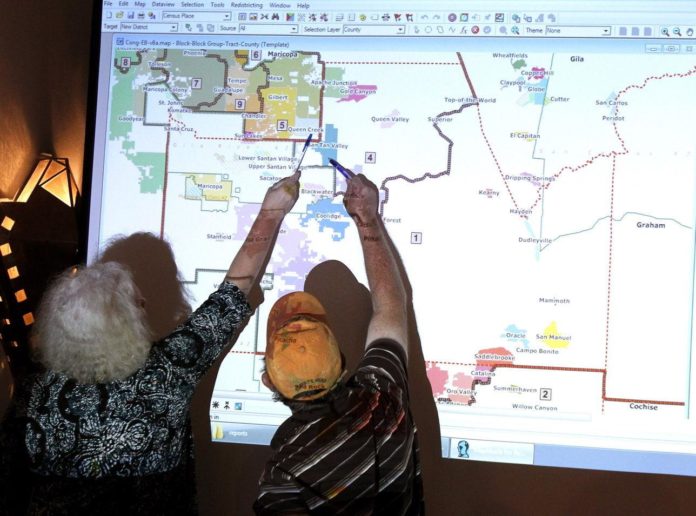
The Arizona commission charged with redrawing maps for congressional and legislative districts every decade approved its basic starting-point grid maps Tuesday, kicking off a months-long process with huge political implications where the boundaries will be heavily tweaked before being finalized.
The grid maps for the state’s nine congressional and 30 legislative districts differ greatly from the state’s current map. They are also nothing like what the final new maps will outline, according to the chair of the Arizona Independent Redistricting Commission.
Instead, it is a basic map that breaks up Arizona’s 7.15 million residents into equal parts by census tract.
“Please remember it is an arbitrary starting point,” Commission Chair Erika Neuberg said. “There’s no meaning behind these lines outside of equal population.”
How the commission changes the grid map could have vast political consequences because they can affect the ability of parties to elect their candidates.
The state’s current congressional delegation consists of four Republicans and five Democrats, although the 2nd Congressional District has swung from Democrat to Republican and back over the past decade. The state Legislature is also closely divided, with Republicans holding just a one-seat advantage in both chambers. Republicans have slowly lost seats over the past decade as the state’s voters moved from solidly red to more competitively balanced.
The commission, if it has the votes, could let that trend continue or tip the scales to one party or the other by how it divvies up populations and registered voters. It is made up of two Democrats, two Republicans, and Neuberg, who is an independent.
How she votes as the chair and tiebreaker as the mapmaking decisions start to be made will be closely watched by political parties. Two early commission decisions, on the mapping consultant and the panel’s executive director, left the Democrats unhappy. But it remains unclear where Neuberg will come down on more substantive decisions.
The commission’s contract map-makers started the grid map at the six-way intersection of Grand and 19th avenues and McDowell Road, where the state fairgrounds is located in central Phoenix, then broke the state into four quadrants, moving clockwise. All the congressional and legislative districts are within one person of being equal — 794,612 people per congressional district and 239,384 per legislative district, or one fewer.
The final maps will be able to have up to a plus or minus 5% difference in population.
Now that it has approved grid maps that contain draft districts with equal populations that are compact and connected, commissioners will consider the four other factors the state constitution says it must weigh in setting up the real districts. They are complying with the U.S. Constitution and the Voting Rights Act, keeping “communities of interest” together, considering features such as city, town, and county boundaries, and creating competitive districts.
Rejiggering the maps is a complex process because each move of a line requires corresponding moves in other districts to keep populations relatively close.
The commission has scheduled a series of five public meetings to get input on those factors, with the first Sept. 21 in Mesa with viewing sites set up in Yuma and at Window Rock on the Navajo Nation. The other hearings also have remote participation options.
Arizona was widely expected to get a 10th congressional seat after last year’s Census, but the state grew at a slower pace than expected and lost out on that added representation. Detailed Census data was provided to the commission last month that allowed the map-making process to shift into high gear.
The redistricting commission was created by voters in 2000 to limit political influence by the Legislature in redrawing congressional and legislative district maps.
Republicans generally liked the district maps drawn after the 2000 census, and those done following the 2010 census were regarded as more favorable to Democrats, prompting strong criticism from Republicans.
The 2001 and 2011 maps led to prolonged court challenges, including a 2015 U.S. Supreme Court decision that upheld Arizona voters’ decision to strip the redistricting process from the Legislature.
Republished with the permission of the Associated Press.













